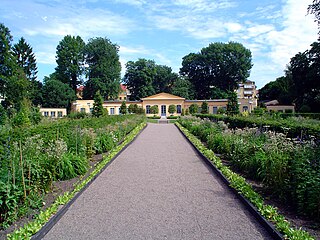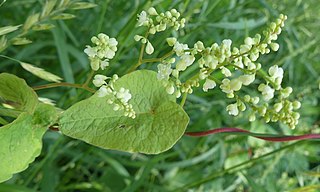
The Araliaceae are a family of flowering plants composed of about 43 genera and around 1500 species consisting of primarily woody plants and some herbaceous plants commonly called the ginseng family. The morphology of Araliaceae varies widely, but it is predominantly distinguishable based on its woody habit, tropical distribution, and the presence of simple umbels.
In biology, a tribe is a taxonomic rank above genus, but below family and subfamily. It is sometimes subdivided into subtribes. By convention, all taxonomic ranks from genus upwards are capitalized, including both tribe and subtribe.

The International Code of Nomenclature for algae, fungi, and plants is the set of rules and recommendations dealing with the formal botanical names that are given to plants, fungi and a few other groups of organisms, all those "traditionally treated as algae, fungi, or plants". It was formerly called the International Code of Botanical Nomenclature (ICBN); the name was changed at the International Botanical Congress in Melbourne in July 2011 as part of the Melbourne Code which replaced the Vienna Code of 2005.

Aralia, or spikenard, is a genus of the family Araliaceae, consisting of 68 accepted species of deciduous or evergreen trees, shrubs, and rhizomatous herbaceous perennials. The genus is native to Asia and the Americas, with most species occurring in mountain woodlands. Aralia plants vary in size, with some herbaceous species only reaching 50 centimetres (20 in) tall, while some are trees growing to 20 metres (66 ft) tall.

A botanical name is a formal scientific name conforming to the International Code of Nomenclature for algae, fungi, and plants (ICN) and, if it concerns a plant cultigen, the additional cultivar or Group epithets must conform to the International Code of Nomenclature for Cultivated Plants (ICNCP). The code of nomenclature covers "all organisms traditionally treated as algae, fungi, or plants, whether fossil or non-fossil, including blue-green algae (Cyanobacteria), chytrids, oomycetes, slime moulds and photosynthetic protists with their taxonomically related non-photosynthetic groups ."
Nomenclature codes or codes of nomenclature are the various rulebooks that govern biological taxonomic nomenclature, each in their own broad field of organisms. To an end-user who only deals with names of species, with some awareness that species are assignable to families, it may not be noticeable that there is more than one code, but beyond this basic level these are rather different in the way they work.
In botany, an infraspecific name is the scientific name for any taxon below the rank of species, i.e. an infraspecific taxon or infraspecies. A "taxon", plural "taxa", is a group of organisms to be given a particular name. The scientific names of botanical taxa are regulated by the International Code of Nomenclature for algae, fungi, and plants (ICN). This specifies a three part name for infraspecific taxa, plus a connecting term to indicate the rank of the name. An example of such a name is Astrophytum myriostigma subvar. glabrum, the name of a subvariety of the species Astrophytum myriostigma.

Bunzō Hayata was a Japanese botanist noted for his taxonomic work in Japan and Formosa, present day Taiwan.

Coleus barbatus, also known by the synonyms Plectranthus barbatus and incorrectly Coleus forskalaei, is a tropical perennial plant related to the typical coleus species. It produces forskolin, an extract useful for pharmaceutical preparations and research in cell biology.
Aralia hypoglauca is a species of flowering plant in the family Araliaceae. It is an epiphytic shrub native to Guangxi and southwestern Hunan provinces of China. It has been treated as the only species Hunaniopanax hypoglaucus of the genus Hunanioglaucus.
Aralia wangshanensis is a species of plant in the family Araliaceae. It is endemic to China.
Galium hardhamiae is a species of flowering plant in the coffee family Rubiaceae, known by the common name Hardham's bedstraw. The scientific name may be misspelled Galium hardhamae. It is endemic to the Santa Lucia Range of southern Monterey County and northern San Luis Obispo County in California. It is a member of the serpentine soils flora in these coastal mountains. This is a perennial herb forming mats or clumps of stems no more than 30 centimeters long. The stems have many whorls of six fleshy green leaves, each leaf just 1 to 3 millimeters long. The inflorescences, clusters of yellow-green to pinkish flowers, appear in leaf axils.

Vriesea wawrana is a plant species in the genus Vriesea. This species is endemic to Brazil.
Aralia dasyphylloides is a species of flowering plant in the family Araliaceae, native to south China. Some sources have included it in Aralia dasyphylla.

Cranfillia fullagari, synonym Blechnum fullagarii, is a fern in the family Blechnaceae. The specific epithet honours James Fullagar, who collected plants on Lord Howe Island for the Royal Botanic Gardens, Melbourne.

Quercus margarettae, the sand post oak or dwarf post oak, is a North American species of oak in the beech family. It is native to the southeastern and south-central United States from Virginia to Florida and west as far as Texas and Oklahoma. There are historical reports of the species growing in New York State, but it has not been seen there in years.
Ponerorchis tominagae is a species of flowering plant in the family Orchidaceae, native to Taiwan.

Polygonum ciliinode is a species of flowering plant in the family Polygonaceae, native to central and eastern Canada, and the north-central and eastern United States. The specific epithet is also spelt cilinode.

Taxon is a bimonthly peer-reviewed scientific journal covering plant taxonomy. It is published by Wiley on behalf of the International Association for Plant Taxonomy, of which it is the official journal. It was established in 1952 and is the only place where nomenclature proposals and motions to amend the International Code of Nomenclature for algae, fungi, and plants can be published. The editor-in-chief is Dirk C. Albach.
Cyperus setigerus is a species of sedge that is native to central and southern parts of the United States, recorded from Kansas, Oklahoma, Texas, Missouri, and New Mexico.










